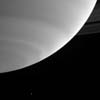|
Free Newsletters - Space News - Defense Alert - Environment Report - Energy Monitor |
| . |  |
. |
|
|
Titan: The Day Of Descent
When ESA's Huygens probe plunges into the atmosphere of Saturn's largest moon, Titan, on 14 January 2005, telescopes on Earth will be watching the remote world. Observations of Titan from Earth will help to understand the global condition of the atmosphere, while Huygens is passing through a tiny section of it. As Huygens drifts down, its instruments and cameras will be collecting vital information about the atmosphere and surface. The Cassini mothership will be listening, so that it can later transmit the results to Earth but, while Cassini is pointing its high-gain antenna at Huygens, it cannot watch Titan with its cameras. So telescopes on Earth will try to do the job. The telescopes located around the Pacific Ocean will be used because Titan will be in view from these areas at the time of the Huygens descent. An observation from space, by the NASA/ESA Hubble Space Telescope, is also planned. The most exciting possibility is that the observations may show a tiny, bright speck at the moment Huygens enters the atmosphere. This point of light will be the 'fireball', created by friction as the probe's heatshield hurtles through the denser parts of the moon's atmosphere and the spacecraft shoots across Titan's sky like a giant meteor. Although the chances of seeing the fireball are faint, the best location to be looking from happens to coincide with the largest single telescope in the world: the 10-metre Keck telescope. Situated on the summit of the dormant volcano Mauna Kea, on Hawaii, Keck will be directly in line with Titan at the moment of the Huygens descent. In addition to optical telescopes, a string of radio telescopes across America, Australia, China and Japan will team up to listen for the faint radio signal of Huygens itself. If they hear this tiny call, they will be able to help determine, after weeks of processing the Huygens amount of data that will be collected, the precise landing location for the probe on Titan's surface. Jean-Pierre Lebreton, Huygens Project Scientist, will be in ESA's European Space Operations Centre (ESOC) at Darmstadt, Germany, during the descent of the probe. As any space scientist knows, planetary descents can be risky things. However, Lebreton says that preparations for the day of descent are going well, and adds, "We have no time to get nervous, there is too much work to do." Related Links Cassini-Huygens mission at JPL Italian Space Agency SpaceDaily Search SpaceDaily Subscribe To SpaceDaily Express  Pasadena CA (JPL) Nov 04, 2004
Pasadena CA (JPL) Nov 04, 2004Cassini spied the moon Enceladus in the distance beyond Saturn's south pole in this image from Sept. 19, 2004. This view was taken in wavelengths of ultraviolet light where gas molecules in Saturn's high atmosphere scatter a great deal of sunlight.
|
| |||||||||||
| The content herein, unless otherwise known to be public domain, are Copyright 1995-2016 - Space Media Network. All websites are published in Australia and are solely subject to Australian law and governed by Fair Use principals for news reporting and research purposes. AFP, UPI and IANS news wire stories are copyright Agence France-Presse, United Press International and Indo-Asia News Service. ESA news reports are copyright European Space Agency. All NASA sourced material is public domain. Additional copyrights may apply in whole or part to other bona fide parties. Advertising does not imply endorsement, agreement or approval of any opinions, statements or information provided by Space Media Network on any Web page published or hosted by Space Media Network. Privacy Statement All images and articles appearing on Space Media Network have been edited or digitally altered in some way. Any requests to remove copyright material will be acted upon in a timely and appropriate manner. Any attempt to extort money from Space Media Network will be ignored and reported to Australian Law Enforcement Agencies as a potential case of financial fraud involving the use of a telephonic carriage device or postal service. |